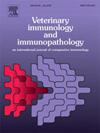Establishment of B4-100 and B4-C4, clonal canine multiple myeloma cell lines and their application in generating monoclonal antibody-producing fully canine hybridomas
IF 1.4
3区 农林科学
Q4 IMMUNOLOGY
引用次数: 0
Abstract
We report on the establishment of the unique canine multiple myeloma cloned cell lines B4–100 and B4-C4, established from the peripheral blood of a canine patient with suspected lymphoma. The cloned cells were analyzed for morphologic traits, proliferation rates, cell doubling times, as well as canine immunoglobulin production by flow cytometry. The cells were found to express IgE in the cell lysate by western blotting but did not express HGPRT, and were unable to grow in hypoxanthine-aminopterin-thymidine medium. When the cells were fused with canine peripheral blood mononuclear cells in vitro, hybridomas producing canine immunoglobulins in the culture supernatant could be generated. To our knowledge, this is the first report on establishment of canine myeloma cell lines and we submit that these cell lines may provide opportunities for the production of fully caninized antibodies with potential for therapeutic applications.
犬多发性骨髓瘤克隆细胞系B4-100和B4-C4的建立及其在产生单克隆抗体的全犬杂交瘤中的应用
我们报告建立独特的犬多发性骨髓瘤克隆细胞系B4-100和B4-C4,建立从犬的外周血疑似淋巴瘤患者。用流式细胞术分析克隆细胞的形态特征、增殖率、细胞倍增率以及犬免疫球蛋白的产生。western blotting发现细胞在细胞裂解液中表达IgE,但不表达HGPRT,并且在次黄嘌呤-氨基蝶呤-胸腺嘧啶培养基中不能生长。将细胞与犬外周血单核细胞体外融合后,培养上清可产生产生犬免疫球蛋白的杂交瘤。据我们所知,这是关于建立犬骨髓瘤细胞系的第一份报告,我们认为这些细胞系可能为生产具有治疗应用潜力的完全犬化抗体提供机会。
本文章由计算机程序翻译,如有差异,请以英文原文为准。
求助全文
约1分钟内获得全文
求助全文
来源期刊
CiteScore
3.40
自引率
5.60%
发文量
79
审稿时长
70 days
期刊介绍:
The journal reports basic, comparative and clinical immunology as they pertain to the animal species designated here: livestock, poultry, and fish species that are major food animals and companion animals such as cats, dogs, horses and camels, and wildlife species that act as reservoirs for food, companion or human infectious diseases, or as models for human disease.
Rodent models of infectious diseases that are of importance in the animal species indicated above,when the disease requires a level of containment that is not readily available for larger animal experimentation (ABSL3), will be considered. Papers on rabbits, lizards, guinea pigs, badgers, armadillos, elephants, antelope, and buffalo will be reviewed if the research advances our fundamental understanding of immunology, or if they act as a reservoir of infectious disease for the primary animal species designated above, or for humans. Manuscripts employing other species will be reviewed if justified as fitting into the categories above.
The following topics are appropriate: biology of cells and mechanisms of the immune system, immunochemistry, immunodeficiencies, immunodiagnosis, immunogenetics, immunopathology, immunology of infectious disease and tumors, immunoprophylaxis including vaccine development and delivery, immunological aspects of pregnancy including passive immunity, autoimmuity, neuroimmunology, and transplanatation immunology. Manuscripts that describe new genes and development of tools such as monoclonal antibodies are also of interest when part of a larger biological study. Studies employing extracts or constituents (plant extracts, feed additives or microbiome) must be sufficiently defined to be reproduced in other laboratories and also provide evidence for possible mechanisms and not simply show an effect on the immune system.

 求助内容:
求助内容: 应助结果提醒方式:
应助结果提醒方式:


